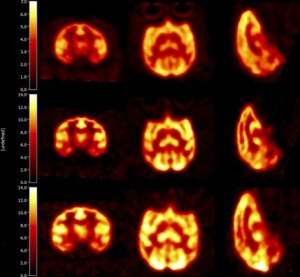por
Lauren Dubinsky, Senior Reporter | June 27, 2018

Chemical structures and brain PET images
of 18F-labeled SV2A PET tracers,
18F-SDM-7, 18F-SDM-8,
and 11C-UCB-J in nonhuman primates
There remains no cure for Alzheimer’s and certain other neurodegenerative diseases, but new research presented on Sunday at the SNMMI annual meeting could help change that.
A team at Yale University developed a new PET radiotracer that can measure synaptic density, which is one of the earliest and most robust biomarkers for AD.
“The fact that there remain no disease-modifying drugs after decades of great efforts drives us to consider early intervention as a possibly more effective strategy to treat AD,” Zhengxin Cai, of the Department of Radiology and Biomedical Imaging at Yale, told HCB News. “With new treatments being tested, a biomarker for reliable, early diagnosis and prognosis of AD will enable more effective intervention before severe neurodegeneration sets in.”



Ad Statistics
Times Displayed: 5354
Times Visited: 15 These online auctions feature Surplus Medical Equipment Extracted from Featuring A Variety of Medical Equipment & Consumables from A Bergen County, NJ Plastic Surgeon & Rensselear, NY BioTech Lab Location: 81 Hamburg Tpk, Riverdale, NJ 07457, US
Previous research uncovered a radiotracer called 11C-UCB-J that can image synaptic density, but it was shown to be unfeasible for clinical use. Cai and his team synthesized and assessed a variety of SV2A tracers that have high brain uptake, fast tissue kinetics and high specific binding signals in the brain.
They developed 18F-labeled SV2A tracers with imaging characteristics that are similar to those of 11C-UCB-J. However, it has a longer half-life, which makes it suitable for multicenter clinical trials, clinical trials and possibly commercialization.
“There was no accepted
in vivo imaging method to quantify synaptic density until the first PET imaging of synapses was recently published by my colleagues,” said Cai.
This radiotracer can help identify which patients may benefit from a certain treatment and then evaluate treatment response. The researchers believe this tracer will also play an important role in central nervous system drug discovery and development.

